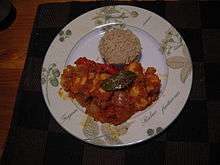Dopiaza
Dopiaza (Persian: دوپیازه meaning "two onions") is the name of two separate dishes one in Afghanistan and one in South Asia. It is prepared with many onions,[lower-alpha 1] both cooked in the spices and curry[2] and as a garnish. Onions are added at two stages during cooking, hence the name. The dish usually contains a meat, usually beef, chicken, lamb,[2] mutton, or shrimp; however, it can also be prepared in a vegetarian style.
| Course | Main course |
|---|---|
| Region or state | Iran and South Asia |
| Main ingredients | Meat, onions, curry |

History
This dish originated in Khorasan (present-day Iran and Afghanistan) was introduced to South Asia by the Mughals (1526-1857), has become popular in India, Pakistan, and many other countries around the world and became a staple of Mughal cuisine.
Iranian dopiaza
Dopiazeh is a traditional dish from Shiraz and it can be made with cubed or ground lamb/beef, chicken, shrimp, potatoes, and a copious amount of sliced onions. Aloo in standard Persian means plum and it is also a term used in Shirazi Persian to mean potatoes.
Ingredients
As many other Hyderabadi dishes, the addition of a sour agent is a key part of dopiaza. Most often, raw mangoes are used; however, lemon juice or cranberries can be used as well. Basic ingredients for dopiaza are chicken or other meats, onions, ginger and garlic paste, whole hot spices (black cardamoms, cloves and peppercorns), salt and chili powder.
Iranian Dopiaza may be prepared using potatoes, onion, turmeric powder, tomato paste, dried fenugreek leaves, and spices.
See also
- Kairi ka Do Pyaza
- List of onion dishes
- Mullah Do Piaza
Notes
- "Dopiaza, the Indian title of this dish, indicates that it contains twice the amount of onions as meat."[1]
References
- Time-Life Books (1988). Fresh ways with pork. Healthy home cooking. Time-Life Books. ISBN 978-0-8094-6033-5. Retrieved 22 August 2019.
- Basu, Mallika (16 December 2015). "Lamb Dopiaza: an alternative recipe for Christmas Day". Evening Standard. Retrieved 22 August 2019.
External links
| Wikimedia Commons has media related to Dopiaza. |


